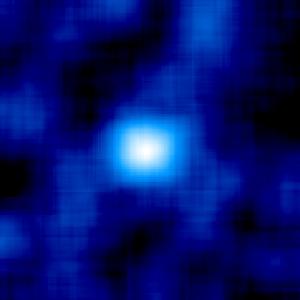Puzzling Milky Way Companion Found

Astronomers have spotted a faint cluster of stars in or near our galaxy, but they're not sure what to call the grouping.
The star clump is a companion to our galaxy. It could be an object known as a dwarf galaxy. Or it might be a globular cluster, one of more than 100 that float within the gravitational influence of the Milky Way. A handful of globular clusters are thought to be remnants of very ancient galaxies consumed to make ours larger.
The cluster, catalogued as SDSSJ1049+5103, resides not along the main plane of the Milky Way but in a sparsely populated halo, hovering about 60 degrees above the main galactic plane.
It is some 150,000 light-years away from us in the direction of the constellation Ursa Major, which includes the Big Dipper. The cluster is a similar distance away from the center of the galaxy.
Category unknown
"We discovered this object in a search for extremely dim companion galaxies to the Milky Way," said Beth Willman of New York University's Center for Cosmology and Particle Physics. "However, it is 200 times less luminous than any galaxy previously seen."
The cluster contains just thousands or maybe only a few hundred stars -- much less than the hundreds of thousands typically found in globular clusters. It is also called Willman 1 for its discoverer.
Get the Space.com Newsletter
Breaking space news, the latest updates on rocket launches, skywatching events and more!
"The object is new, hard to categorize, and unusual," Willman told SPACE.com. "Willman 1 is quite puny in the grand scheme of things."
Puny, but perhaps crucial to understand how galaxies form.
"It is dimmer than all but three known globular clusters," explained colleague Michael Blanton, also of NYU. "Moreover, these dim globular clusters are all much more compact than Willman 1. If it's a globular cluster, it is probably being torn to shreds by the gravitational tides of the Milky Way."
A dark possibility
There might be a way to figure out what to call the thing.
If it is a galaxy, then it ought to contain a bunch of dark matter, mysterious stuff that can't be seen but that contributes more mass to galaxies than the collective heft of stars, gas, planets and dust. Problem is, nobody knows how to detect dark matter directly. It's only suspected because without it, galaxies don't have enough mass to hold together as they do.
Scientists want to know what dark matter is made of and what role it plays in the birth and development of galaxies. A first step, however, is to figure out exactly where the stuff hides.
Most astronomers think the Milky Way is surrounded by hundreds of clumps of dark matter, each of which might include a dim dwarf galaxy. Yet only 11 dwarf galaxies have been found around the Milky Way.
Perhaps, theorists speculate, some of the dwarfs contain very few stars and are just too hard to find with current technology. It follows that perhaps Willman 1 is an example of these.
"If this new object is in fact a dwarf galaxy, it may be the tip of the iceberg of a yet-unseen population of ultra-faint dwarf galaxies," Willman said.
Ambiguity reigns
Another possibility is that Willman 1 hints at all of the above.
"The colors of the stars in Willman 1 are similar to those in the Sagittarius tidal stream, a former dwarf companion galaxy to the Milky Way now in the process of merging into the main body of our galaxy," said Brian Yanny, an astrophysicist at the Department of Energy's Fermi National Accelerator Laboratory.
"If Willman 1 is a globular cluster," Yanny said, "then it may have piggybacked a ride into our galaxy's neighborhood on one of these dwarf companions, like a tiny mite riding in on a flea as it, in turn, latches onto a massive dog."
"The ambiguity of the new object re-raises the question of whether some small fraction of things classified as globular clusters may be the stripped down remains of what used to be a dwarf galaxy," Willman said via email.
The finding was made with observations from the Sloan Digital Sky Survey.
More observations of the star cluster might allow researchers to figure out how to categorize it, which would allow a better understanding of how our Milky Way formed.
- More Evidence of Galaxy Gobbling
Join our Space Forums to keep talking space on the latest missions, night sky and more! And if you have a news tip, correction or comment, let us know at: community@space.com.

Rob has been producing internet content since the mid-1990s. He was a writer, editor and Director of Site Operations at Space.com starting in 1999. He served as Managing Editor of LiveScience since its launch in 2004. He then oversaw news operations for the Space.com's then-parent company TechMediaNetwork's growing suite of technology, science and business news sites. Prior to joining the company, Rob was an editor at The Star-Ledger in New Jersey. He has a journalism degree from Humboldt State University in California, is an author and also writes for Medium.











